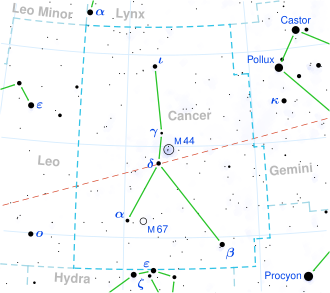Location of LHS 2090 in the constellation Cancer | |
| Observation data Epoch J2000.0 Equinox J2000.0 | |
|---|---|
| Constellation | Cancer [1] |
| Right ascension | 09h 00m 23.546s [2] |
| Declination | +21° 50′ 04.90″ [2] |
| Apparent magnitude (V) | 16.11 [3] |
| Characteristics | |
| Evolutionary stage | Main sequence [3] |
| Spectral type | M6.5 V [4] |
| Apparent magnitude (J) | 9.44 [3] |
| Astrometry | |
| Radial velocity (Rv) | +23.3 [3] km/s |
| Proper motion (μ) | RA: −514.942 mas/yr [2] Dec.: −592.253 mas/yr [2] |
| Parallax (π) | 157.2686±0.0535 mas [2] |
| Distance | 20.739 ± 0.007 ly (6.359 ± 0.002 pc) |
| Details | |
| Mass | 0.09 [5] M☉ |
| Radius | 0.12 [6] R☉ |
| Luminosity | 0.00082 [7] L☉ |
| Temperature | 2680±24 [7] K |
| Metallicity [Fe/H] | −0.06±0.17 [8] dex |
| Rotation | 0.439 d [6] |
| Rotational velocity (v sin i) | 15.0±1.0 [6] km/s |
| Other designations | |
| LHS 2090, LP 368-128, NLTT 20726, 2MASS J09002359+2150054 [9] | |
| Database references | |
| SIMBAD | data |
LHS 2090 is a red dwarf star of spectral type M6.5V, located in constellation Cancer at 20.74 light-years from Earth. [2]
The star was identified to be a nearby red dwarf (6 parsecs from Sun) in 2001, [10] and its parallax was first measured in 2006. [11] As typical for very cool red dwarfs, its spectrum is dominated by molecular water absorption. The stellar metallicity is similar to that of the Sun. [8]
Radial velocity measurements did not yield any detection of a stellar companion or giant planet in orbit around LHS 2090, as of 2018. [3]
